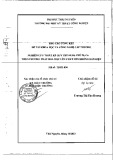
RESEARC H Open Access
Latency profiles of full length HIV-1 molecular
clone variants with a subtype specific promoter
Renée M van der Sluis, Georgios Pollakis, Marja L van Gerven, Ben Berkhout and Rienk E Jeeninga
*
Abstract
Background: HIV-1 transcription initiation depends on cellular transcription factors that bind to promoter
sequences in the Long Terminal Repeat (LTR). Each HIV-1 subtype has a specific LTR promoter configuration and
even minor sequence changes in the transcription factor binding sites (TFBS) or their arrangement can impact
transcriptional activity. Most latency studies have focused on HIV-1 subtype B strains, and the degree to which LTR
promoter variation contributes to differences in proviral latency is therefore largely unknown. Latency differences
may influence establishment and size of viral reservoirs as well as the possibility to clear the virus by therapeutic
intervention.
Results: We investigated the proviral transcriptional latency properties of different HIV-1 subtypes as their LTRs
have unique assemblies of transcription factor binding sites. We constructed recombinant viral genomes with the
subtype-specific promoters inserted in the common backbone of the subtype B LAI isolate. The recombinant
viruses are isogenic, except for the core promoter region that encodes all major TFBS, including NFB and Sp1
sites. We developed and optimized an assay to investigate HIV-1 proviral latency in T cell lines. Our data show that
the majority of HIV-1 infected T cells only start viral gene expression after TNFaactivation.
Conclusions: There were no gross differences among the subtypes, both in the initial latency level and the activation
response, except for subtype AE that combines an increased level of basal transcription with a reduced TNFaresponse.
This subtype AE property is related to the presence of a GABP instead of NFB binding site in the LTR.
Background
Combined antiretroviral therapy (cART) is able to sup-
press the HIV-1 plasma RNA load in patients to undetect-
able levels. Unfortunately, the treatment does not lead to a
complete eradication of the virus from the infected indivi-
dual. Even after many years of successful cART, the virus
rebounds from latently integrated proviral DNA reservoirs
and re-establishes systemic infection upon interruption of
therapy [1-4]. HIV-1 proviral latency may be an effective
means to evade the immune system, since the infected cell
will go unnoticed by the immune system as long as viral
antigens are not expressed and presented. The pool of
latent proviruses is established early during infection and
forms a steady source of proviral DNA that can last a life-
time for infected individuals [5-7]. The majority of the
latent proviruses reside in long-lived memory CD4
+
T cells, but other cellular reservoirs, such as monocytes,
macrophages and dendritic cells, can also harbor latent
proviruses [8-11]. HIV-1 latency remains a formidable bar-
rier towards virus eradication as therapeutic attempts to
purge these reservoirs have been unsuccessful [3,9,12,13].
Previously reported contributors to proviral latency
include suppressive effects of cellular microRNAs, an
impaired viral Tat-TAR axis, and epigenetic silencing
via histone modification and DNA hypermethylation
[14-18]. Most of these modulators have been studied in
artificial cell line models for HIV-1 latency, but some of
these mechanisms were found to be operational in rest-
ing CD4
+
T-cells from HIV infected patients [19,20].
HIV-1 transcriptional activation from latency depends
on cellular transcription factors that bind to the Long
Terminal Repeat (LTR) promoter. Differences in promo-
ter activity among the HIV-1 subtypes have been
reported, consistent with the fact that their LTRs have
specific configurations of transcription factor-binding
* Correspondence: r.jeeninga@amc.uva.nl
Laboratory of Experimental Virology, Department of Medical Microbiology,
Centre for Infection and Immunity Amsterdam (CINIMA), Academic Medical
Centre, University of Amsterdam, Meibergdreef 15, 1105 AZ Amsterdam, the
Netherlands
van der Sluis et al.Retrovirology 2011, 8:73
http://www.retrovirology.com/content/8/1/73
© 2011 van der Sluis et al; licensee BioMed Central Ltd. This is an Open Access article distributed under the terms of the Creative
Commons Attribution License (http://creativecommons.org/licenses/by/2.0), which permits unrestricted use, distribution, and
reproduction in any medium, provided the original work is properly cited.






























